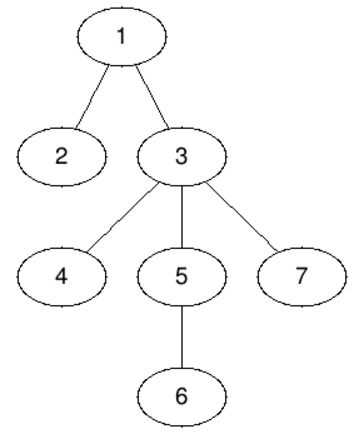Codeforces 685B 树形dp
Input
The first line of the input contains two integers n and q (2 ≤ n ≤ 300 000, 1 ≤ q ≤ 300 000) — the size of the initial tree and the number of queries respectively.
The second line contains n - 1 integer p2, p3, ..., pn (1 ≤ pi ≤ n) — the indices of the parents of the nodes from 2 to n. Node 1 is a root of the tree. It's guaranteed that pi define a correct tree.
Each of the following q lines contain a single integer vi (1 ≤ vi ≤ n) — the index of the node, that define the subtree, for which we want to find a centroid.
For each query print the index of a centroid of the corresponding subtree. If there are many suitable nodes, print any of them. It's guaranteed, that each subtree has at least one centroid.
7 4 1 1 3 3 5 3 1 2 3 5
3 2 3 6

The first query asks for a centroid of the whole tree — this is node 3. If we delete node 3 the tree will split in four components, two of size 1 and two of size 2.
The subtree of the second node consists of this node only, so the answer is 2.
Node 3 is centroid of its own subtree.
The centroids of the subtree of the node 5 are nodes 5 and 6 — both answers are considered correct.
粘一下别人的题解:
先算出每个子树的节点个数,然后找里面最大的一棵子树,重心必然在这棵子树上(很明显的,因为重心是删除它之后,剩下的子树里面节点最大的最小,所以重心应该是在最大的子树里面),然后必然是在最大的子树的重心的上面,这也是显然的,所以可以直接从最大的子树的重心往上,直到找到第一个点满足
#include<bits/stdc++.h>
using namespace std;
const int N=3e5+9;
int f[N],ans[N],num[N];
vector<int>e[N];
void dfs1(int u)
{
num[u]=1;
for(int i=0;i<e[u].size();i++){
int v=e[u][i];
dfs1(v);
num[u]+=num[v];
}
}
void dfs2(int u)
{
ans[u]=u;
int p=0;
for(int i=0;i<e[u].size();i++){
int v=e[u][i];
dfs2(v);
if(num[v]>num[e[u][p]])p=i;
}
if(e[u].size()>0){
ans[u]=ans[e[u][p]];
while(ans[u]!=u){
if(num[ans[u]]>=num[u]-num[ans[u]])break;
ans[u]=f[ans[u]];
}
}
}
int main()
{
int n,q;
cin>>n>>q;
for(int i=2;i<=n;i++){
scanf("%d",&f[i]);
e[f[i]].push_back(i);
}
dfs1(1);
dfs2(1);
while(q--){
int x;
scanf("%d",&x);
printf("%d\n",ans[x]);
}
return 0;
}



